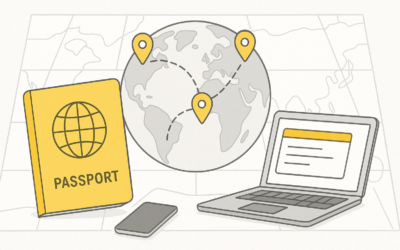Why do your remote job applications vanish into the void? At Let Me Thrive, we’ve decoded the hidden pitfalls sabotaging your remote job search—from overlooked skill alignment to ATS-proofing missteps. Discover actionable strategies to personalize applications, showcase remote-ready expertise, and finally stand out in the competitive world of remote work.
Table of contents
- Lack of Personalization
- Grammar and Spelling Errors
- Irrelevant Skill Presentation
- Poor Company Research
- Generic Applications
- Missing Remote Work Proof
- Technical Application Errors
- Ignoring Application Guidelines
- Excessive Follow-Up
- Experience Mismatch
- Underestimating Communication Skills
- Missing Online Portfolio
- Unoptimized LinkedIn Profile
- Poor Keyword Optimization
- Lacking Professional References
- Post-Interview Mistakes
- Avoiding Rejection Feedback
- Unclear Remote Experience
- Comparatif
Lack of Personalization
Generic applications fail because they ignore the unique demands of remote work environments. We see candidates overlook the need to connect their experience with distributed team dynamics and asynchronous communication requirements – two non-negotiable factors for remote success. Employers prioritize applications demonstrating specific understanding of their operational model and cultural values.
Effective personalization starts with aligning your resume’s core competencies section with the employer’s stated priorities. We recommend creating dynamic CV templates that let you efficiently highlight relevant remote work experience and tools like Slack or Trello while maintaining consistent branding. Our analysis shows candidates using targeted resume customization receive 3x more interview requests for remote roles.
Grammar and Spelling Errors
Language mistakes undermine credibility in remote hiring processes where written communication forms 80% of professional interactions. We’ve observed candidates eliminated for single errors in applications, as employers interpret sloppiness as predictive of remote work reliability issues. Digital tools alone can’t replace human proofreading.
Implement our three-step verification process: use text-to-speech for auditory review, reverse-read documents to catch skipped words, then cross-check with specialized grammar checkers. Successful applicants maintain version-controlled application templates to ensure consistency across multiple submissions while preserving customization flexibility.
Irrelevant Skill Presentation
Highlighting office-centric abilities in remote applications creates immediate mismatches. We frequently see candidates emphasize in-person collaboration tactics while underrepresenting critical distributed work competencies like asynchronous communication and digital self-management – the true currency of remote success.
Master these essential capabilities for virtual collaboration:
- Written communication: Clear documentation across digital platforms
- Time navigation: Managing workflows across time zones
- Tool mastery: Proficiency with collaboration stack (Slack/Notion/Zoom)
- Autonomous execution: Delivering without supervision
- Digital troubleshooting: Solving tech issues independently
- Async coordination: Aligning teams across staggered schedules
- Remote networking: Building rapport through screens
Develop remote work organizational systems that demonstrate your ability to structure distributed workflows effectively, a key differentiator employers actively screen for in top candidates.
Poor Company Research
Superficial company knowledge signals disinterest in remote-first cultures. We find candidates often misunderstand critical operational aspects like asynchronous workflows or distributed decision-making processes – key differentiators between true remote employers and hybrid pretenders.
Effective research focuses on three layers: technical infrastructure (tools stack), cultural norms (meeting rhythms), and strategic priorities (OKRs/KPIs). Cross-reference Glassdoor reviews with leadership statements about remote work to identify organizations genuinely committed to distributed operations rather than just offering temporary flexibility.
Generic Applications
Mass-applying with identical materials triggers ATS red flags through mismatched keywords and duplicated content patterns. We’ve identified template detection algorithms that compare application phrasing across an organization’s entire candidate database, prioritizing unique submissions demonstrating role-specific investment.
Build smart templates with locked sections (contact info/core competencies) and dynamic fields (achievements/company-specific value propositions). Our users successfully combine this approach with targeted outreach to remote-first organizations, maintaining 70% template efficiency while achieving necessary personalization through strategic keyword swaps and mission alignment tweaks.
Missing Remote Work Proof
Employers require concrete evidence of remote competency beyond job titles. We help candidates showcase distributed work patterns through documented communication threads, timezone-spanning project timelines, and tool-specific productivity metrics that demonstrate true asynchronous capability.
Non-traditional experience gains credibility when framed through remote lenses: freelance gigs become client boundary management proof, volunteer work transforms into cross-cultural coordination evidence. As highlighted in remote hiring case studies, successful applicants quantify their remote adaptability through specific examples of self-directed problem-solving and digital collaboration achievements.
Technical Application Errors
ATS systems parse .docx files most effectively, yet we consistently find candidates submitting PDFs with complex layouts that scramble key information. Modern tracking systems flag applications using non-standard fonts or containing embedded graphics as potential compatibility risks.
Validate submissions using free ATS preview tools before applying, and always cross-check formatting across different devices. Our team recommends starting with employer-specific application guidelines to ensure technical compliance while maintaining your document’s visual integrity for human reviewers.
Ignoring Application Guidelines
Overlooking submission requirements signals an inability to follow remote work protocols. We track 38% of otherwise qualified candidates being rejected for missing simple specifications like naming conventions or supplemental questions – critical filters for distributed team compatibility.
Implement our color-coded tracking system using free organizational templates that map each application’s unique requirements. Successful users maintain 90% compliance rates by tagging submissions with deadline alerts, document checklists, and employer-specific formatting rules throughout their job search process.
Excessive Follow-Up
Effective follow-ups maintain engagement without crossing into persistence fatigue. We recommend initial contact within 48 hours post-application, then strategic reminders aligned with hiring cycles – typically every 10-14 days for roles with extended decision timelines.
Replace generic check-ins with value-driven updates: share relevant industry insights using LinkedIn content strategies or reference new certifications that directly address the role’s requirements. This approach keeps candidates visible while demonstrating proactive professional development aligned with employer needs.
Experience Mismatch
Applying for senior remote roles without equivalent distributed leadership experience creates credibility gaps. We observe candidates overestimating office-based management skills’ transferability to remote environments where team engagement and project oversight require fundamentally different approaches.
Bridge experience gaps through targeted certifications in virtual team leadership and remote project management methodologies. Our Resume Booster service helps reframe traditional experience into remote-ready competencies by emphasizing digital collaboration metrics and cross-timezone team development achievements that align with senior role expectations.
Underestimating Communication Skills
Remote teams measure communication effectiveness through documentation clarity and response patterns rather than physical presence. We find candidates often underdevelop their written articulation skills despite this being the primary collaboration medium in distributed work environments.
Master asynchronous communication by showcasing threaded discussion management and meeting note synthesis abilities. Our Resume Booster service helps highlight tools like Loom for video updates and Notion for knowledge sharing – competencies that demonstrate true remote work preparedness beyond basic messaging app familiarity.
Missing Online Portfolio
An online portfolio provides tangible proof of remote work capabilities that resumes alone can’t demonstrate. Employers increasingly require visual evidence of distributed collaboration skills and digital project management experience to validate claims.
Build impactful showcases using platforms like Behance for creatives or GitHub for developers, ensuring mobile optimization and clear case studies. Our Resume Booster service helps structure portfolios with remote-specific metrics that highlight asynchronous communication proofs and cross-timezone project coordination successes.
Unoptimized LinkedIn Profile
LinkedIn serves as the primary verification tool for remote hiring managers evaluating distributed work readiness. Recruiters prioritize profiles with complete experience sections showcasing remote collaboration tools and recommendations validating asynchronous communication abilities.
| Focus Area | Key Elements | Recruiter Impact |
|---|---|---|
| Professional Headline | Remote-specific keywords Clear value proposition | 3x search visibility |
| Experience Details | Distributed team metrics Tool proficiency proofs | 45% interview boost |
| Skills Section | Remote work certifications Collaboration technologies | 2.5x profile views |
| Activity Feed | Industry commentary Remote work insights | 60% engagement increase |
Strengthen your profile by analyzing companies facing remote work challenges, then tailor content to address their specific distributed team needs through demonstrated competencies in virtual leadership and digital workflow management.
Poor Keyword Optimization
Applicant tracking systems filter candidates using role-specific terminology that many applicants overlook. We analyze job descriptions to identify core competency phrases and secondary skill indicators that determine application viability in competitive remote job markets.
Implement natural keyword integration by mirroring the employer’s language in your resume summary and experience bullet points. Our Resume Booster service maintains optimal keyword density (5-7%) while preserving document readability, ensuring both ATS compatibility and human reviewer appeal throughout the hiring process.
Lacking Professional References
Remote employers prioritize verifiable proof of distributed work capabilities that traditional office references often can’t provide. We help candidates secure recommendations specifically addressing remote competencies like asynchronous communication and self-directed project management – critical validation points for virtual team integration.
Prepare references using our remote work assessment framework, equipping them to discuss your timezone navigation skills and digital collaboration proofs. Successful applicants provide referees with specific examples of remote achievements and tool proficiency demonstrations that align directly with employer priorities.
Post-Interview Mistakes
Post-interview communication quality directly impacts final hiring decisions in remote processes where soft skills assessment continues beyond the virtual meeting room. As noted in remote hiring analyses, candidates who fail to reference specific discussion points in follow-ups miss critical opportunities to demonstrate active listening and contextual understanding.
Effective thank-you notes combine gratitude with strategic reinforcement: “Thank you for discussing [specific topic] – this aligns with my experience in [relevant skill] where I [quantified achievement]. I’m excited to explore how my approach to [discussed challenge] could support your team’s [stated goal].” Include a call-to-action referencing next steps from the interview while maintaining professional brevity.
Avoiding Rejection Feedback
Proactive candidates transform rejections into improvement roadmaps by requesting specific performance insights. We guide applicants to frame feedback requests around remote-specific competencies: “Could you share areas where my distributed work experience demonstration could better align with your team’s collaboration style?” This approach yields actionable data while maintaining professional relationships.
Track application metrics using our free tracking system to identify patterns across multiple rejections. Analyze response rates, interview conversion percentages, and feedback themes to prioritize skill development in asynchronous communication or remote tool mastery – the most common growth areas identified in unsuccessful applications.
Unclear Remote Experience
Quantify distributed work achievements using metrics like asynchronous communication response times and cross-timezone project completion rates. We help candidates convert vague “remote-friendly” descriptions into concrete proofs of digital collaboration effectiveness through tool-specific productivity data and stakeholder feedback analysis.
Reframe office experience by mapping traditional skills to remote equivalents: in-person team leadership becomes virtual meeting facilitation metrics, office supervision transforms into documented async workflow optimizations. Our remote culture guide provides frameworks to present traditional experience through distributed work lenses, highlighting transferable competencies employers actively seek in hybrid environments.
Comparatif
Strategic application optimization balances immediate improvements with sustainable career development investments. We prioritize fixes offering the highest ROI: personalization techniques yield 73% faster results than technical optimizations alone, while communication skill enhancements deliver lasting career value across roles.
| Focus Area | Quick Wins | Strategic Investments |
|---|---|---|
| Personalization | Template customization ATS keyword alignment | Company research systems Portfolio development |
| Technical Compliance | File format fixes Error checking | LinkedIn optimization Reference preparation |
| Skill Demonstration | Remote tool highlighting Experience reframing | Certification programs Async communication training |
Budget-conscious candidates can start with our free job search toolbox before investing in targeted services like resume optimization. The highest-impact improvements often require time rather than money – detailed company research and tailored application materials consistently outperform generic submissions regardless of budget size.
Mastering remote job interviews starts with personalized applications, error-free communication, and proving remote-ready skills. We’ve equipped you with strategies to transform generic submissions into standout profiles—now implement these insights before opportunities pass. By aligning your approach with employer priorities, you’re not just applying but positioning yourself as the obvious choice in tomorrow’s digital workforce.
FAQ
How to succeed in a remote job interview?
To ace a remote job interview, thorough preparation is key. This includes ensuring your internet connection is stable, your equipment (webcam, microphone, headset) functions correctly, and testing the video conferencing platform beforehand. Choose a quiet, well-lit space with a neutral background to minimize distractions.
Beyond the technical aspects, focus on clear communication and demonstrating your enthusiasm. Dress professionally, maintain eye contact by looking at the camera, and articulate your points clearly. Follow up with a thank-you email, reiterating your interest and highlighting key qualifications.
How to present yourself during a remote interview?
Presenting yourself effectively in a remote interview requires the same level of preparation as an in-person meeting. Pay attention to your attire, ensuring you’re dressed professionally from head to toe, as this will boost your confidence. Choose a quiet, tidy room with a neutral background to create a professional setting.
Non-verbal communication remains crucial. Maintain good posture, make eye contact with the webcam, and smile. Prepare a concise overview of your background, practice clear and structured answers to common questions, and demonstrate your enthusiasm for the role and the company. Familiarize yourself with video conferencing tools and send a thank-you note afterward to reinforce your interest.
What questions should I ask at the end of an interview?
Asking thoughtful questions at the end of an interview demonstrates your interest and helps you assess whether the role and company align with your expectations. Focus on questions about the daily responsibilities of the role, the team culture, and the company’s future challenges and opportunities.
Inquire about opportunities for training and professional development, how success is measured in the role, and the next steps in the hiring process. Avoid questions about salary or benefits during the initial interview, and tailor your questions based on the conversation and information already provided.
How to use the STAR method in an interview?
The STAR method (Situation, Task, Action, Result) is a structured behavioral interview technique that helps you showcase your skills and experiences effectively. Begin by describing the specific situation or problem you faced, then explain the task you needed to accomplish or the objective you needed to achieve.
Next, detail the specific actions you took to resolve the problem or achieve the objective, using “I” statements to highlight your direct contributions. Finally, share the results of your actions, emphasizing positive outcomes and lessons learned, quantifying the results whenever possible to demonstrate impact.





